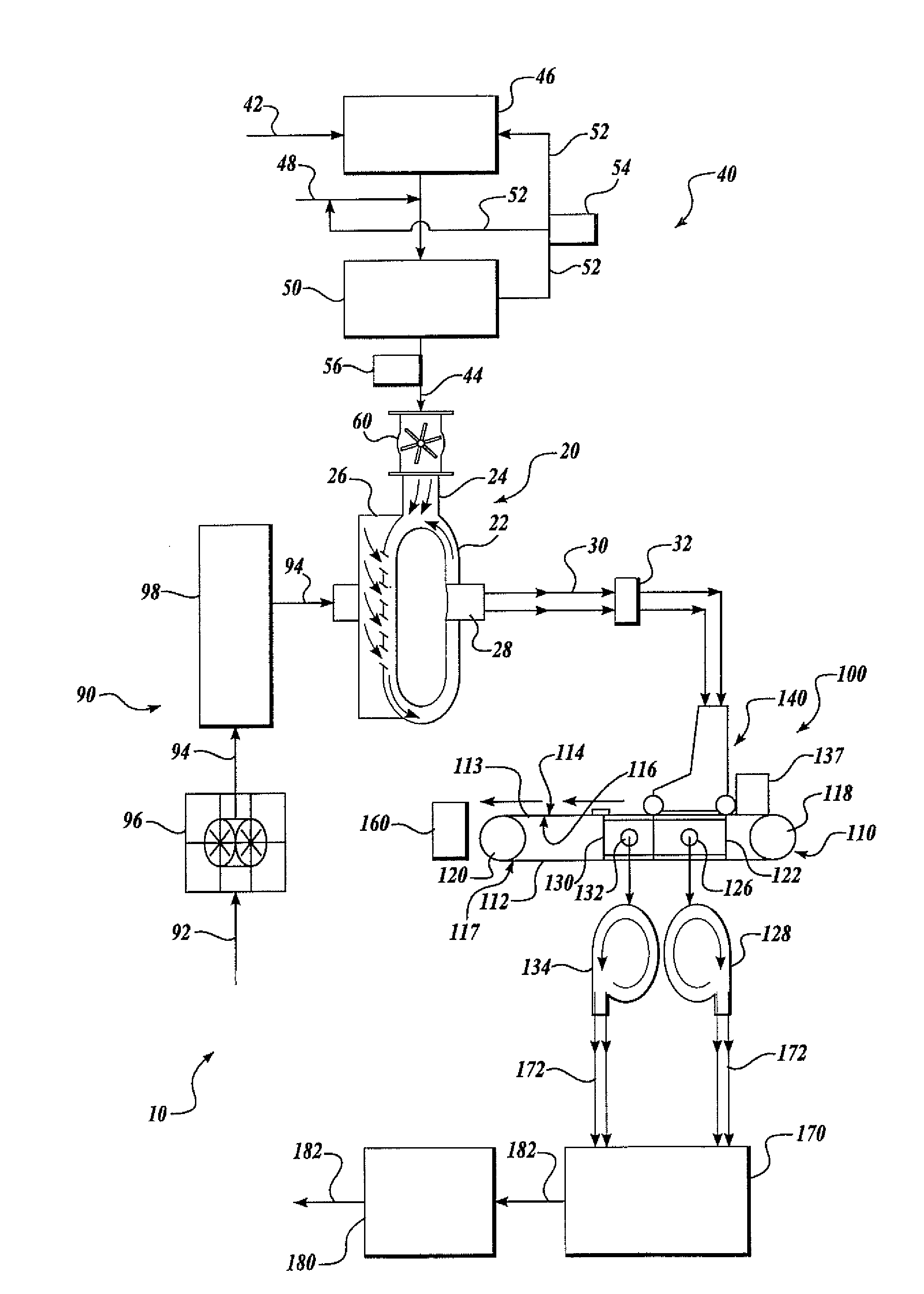System for making dried singulated crosslinked cellulose pulp fibers
a technology of cellulose and crosslinked cellulose, which is applied in the direction of drying machines, filter paper, solid waste management, etc., can solve the problems of high capital expenditure of each piece of processing equipment, steps and pieces of processing equipment, and energy-consuming processes, so as to reduce the amount of knots, increase production rate, and reduce the effect of knots
- Summary
- Abstract
- Description
- Claims
- Application Information
AI Technical Summary
Benefits of technology
Problems solved by technology
Method used
Image
Examples
example 1
[0119]Singulated dried Douglas fir fiber and treated dried Southern pine fiber was produced by making wet rolls of pulp on a pilot papermachine and hand feeding the wet rolls into the shredding device and drier system described above. Some untreated (as is) bleached Southern pine and Douglas fir rolls were dried. Additional Southern pine rolls were treated then dried. The treatments on the separate runs of the Southern pine feed pulp were as follows: 1) Citric acid; 2) Glyoxal; 3) Clay; 4) Hydrophobic latex and fly ash; 5) Hydrophobic latex, fly ash, and superplasticizer; 6) Glyoxal, hydrophobic latex, fly ash, and superplasticizer; 7) Glyoxal, hydrophobic latex, fly ash, methyl cellulose, and superplasticizer; 8) no treatment; 9) fly ash; and 10) clay. The feed rate of the pulp was 25 g / min-111 g / min OD (oven dried). The solids content was approximately 28% in the rolls prior to drying. The outlet temperature of the drier ranged from 180° C. to 200° C. The inlet temperature was var...
example 2
[0121]Unbleached and untreated singulated dried fiber was produced by making wet rolls of unbleached Douglas fir (DF) pulp on a pilot papermachine and hand feeding the wet rolls into the shredding device and drier system described above. The dried fiber was collected and tested for sonic knots which were 5% at one feed rate (in rpm of the feed roller motor into the shredder) and 15% at a higher feed rate. The outlet temperature was maintained at 180° C. for both runs. The fines content was about 11% at the lower feed rate and 12% at the higher feed rate. The accepts were 83% at the lower feed rate and 74% at the higher feed rate. Table 2 summarizes the data.
[0122]
TABLE 2Varying feed rate effects on untreated roll samples.KnotsFeedOutletRun #Pulp(%)AcceptsFinesRate SpeedTemp. (° C.)11DF14.7374.1311.1330018012DF5.0783.0711.87250180
example 3
[0123]Bleached and untreated singulated dried fiber samples were produced by making wet rolls of bleached Douglas fir pulp on a pilot papermachine and hand feeding the wet rolls into the shredding device and drier system described above. The dried fiber was collected and tested to determine the effect of outlet temperature and feed rate on sonic knots and also the effect on fiber strength as measured by wet zero span tensile strength (ZST). The t86% gives a value to establish the lower and upper limits of the error range for the ZST results. There was no statistically significant change in fiber strength. It was found that a higher feed rate produced a higher amount of knots and a higher outlet temperature produced more knots. Table 3 shows the results.
[0124]
TABLE 3Jet drier runs showing effect of temperatureand feed rate on knots and ZST.ZSTIndexKnotsAcceptsFinesShredderOutletFeed RateRun #(Nm / g)t86%(%)(%)(%)SpeedTemp. (° C.)(g OD / min)Control10810.6131065.720.5366.8712.603001607014...
PUM
| Property | Measurement | Unit |
|---|---|---|
| pressure | aaaaa | aaaaa |
| flow rate | aaaaa | aaaaa |
| pressure | aaaaa | aaaaa |
Abstract
Description
Claims
Application Information
 Login to View More
Login to View More - R&D
- Intellectual Property
- Life Sciences
- Materials
- Tech Scout
- Unparalleled Data Quality
- Higher Quality Content
- 60% Fewer Hallucinations
Browse by: Latest US Patents, China's latest patents, Technical Efficacy Thesaurus, Application Domain, Technology Topic, Popular Technical Reports.
© 2025 PatSnap. All rights reserved.Legal|Privacy policy|Modern Slavery Act Transparency Statement|Sitemap|About US| Contact US: help@patsnap.com



